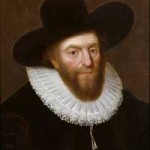Professor Grace Ioppolo writes:
This is an extremely exciting time to be a theatre historian of the age of Shakespeare.
Archaeologists and theatre historians have been recently working together to map the areas around the Southbank of the Thames and the area north of the Thames in Shoreditch where most of the early modern theatres were built. Since the 1980s, Museum of London archaeologists have made some incredible finds, including the original sites in Shoreditch of The Theatre (the first purpose-built theatre, used eventually by Shakespeare’s acting company The Lord Chamberlain’s Men) and The Curtain, as well as the original sites on the Southbank of The Rose and The Globe (which was built from the timber and nails dismantled from The Theatre after a dispute with the free-holder in 1599).
These archaeologists have used cutting-edge technology, including radar scanning, digital 3-D reconstructions and other forms of digital media, to produce new arguments about the building and maintenance of these theatres, and thereby shatter most of our scholarly preconceptions (and in some cases, long-held theories). In fact, most of us have found that our speculations have either been surprisingly right or absolutely wrong, with little leeway between these extremes.
One of the most exciting days of my career was three years ago this month when my friend Julian Bowsher, a senior archaeologist at MOLA (http://www.museumoflondonarchaeology.org.uk/), escorted Prof. R. A. Foakes, (the world’s leading authority on The Rose and other theatres), Prof Carol Rutter, a leading theatre historian, and me around the remains that had just been uncovered of The Theatre. Julian pointed out the boundaries of the inner and outer stage (showing us that the stage wasn’t really where we all thought it had been) and demonstrating how The Theatre’s builders had recycled floor tiles from an abandoned priory on the site. To think that we were standing on a platform just above where Shakespeare and his colleagues had performed his early plays, including his Henry VI plays and such tragedies as Titus Andronicus, was really more than I had could comprehend. And as the founder and director of The Henslowe-Alleyn Digitization Project (http://www.henslowe-alleyn.org.uk/) through which I had digitized all the surviving records of the Rose Theatre and of Shakespeare’s rival entrepreneurs, Philip Henslowe and Edward Alleyn, who had also used The Theatre, I was also thrilled to be standing right over the spot where Alleyn had performed some of his leading roles.
Last year, at a conference I ran at Reading entitled “Who Invented the ‘Shakespearean’ Theatre?”, Museum of London archaeologist Heather Knight announced that she had found the remains of The Curtain, which were not far from The Theatre. Again we were thrilled to hear that another location of Shakespearean (and Alleynian) performance had been located (you can hear Heather’s lecture and a podcast of the entire conference here: http://www.reading.ac.uk/news-and-events/releases/PR469703.aspx).
So once again we had to re-think what we thought we knew about the shape, dimensions and construction of the theatres that hosted the great plays of early modern England.
The English Literature Department at Reading has had a long history of internationally distinguished research into Shakespearean theatres, especially through the work of Prof. Andy Gurr, the world’s leading expert on the Globe (and a long-time consultant in its reconstruction in the modern age as Shakespeare’s Globe in London). Prof. Gurr is also the consultant to the Shakespearean London Theatres Project (known as ShaLT), which has produced a Walking Map of theatres 1567-1642 that is available as a free download along with other resources here: http://shalt.org.uk/downloads. The map includes information drawn from my Henslowe-Alleyn Project, so you can also wander around the Rose site, as well as the animal-baiting arenas that Henslowe and Alleyn ran to suit audiences ranging from aristocrats to commoners.
The next time that you find yourself in London on a bright, sunny (or more usually overcast) day, follow in the footsteps of Shakespeare, Burbage, Henslowe, and Alleyn, not to mention Christopher Marlowe, Ben Jonson, Thomas Middleton and Thomas Heywood, and take a walk around the Shakespearean theatre sites.
Now, if only we can find the original site of Henslowe and Alleyn’s much grander theatre, the Fortune, in Shoreditch, my life will be complete. Come to think of it, Julian and Heather have been dropping hints, so maybe, just maybe, we’ll be walking around that site in the near future.




